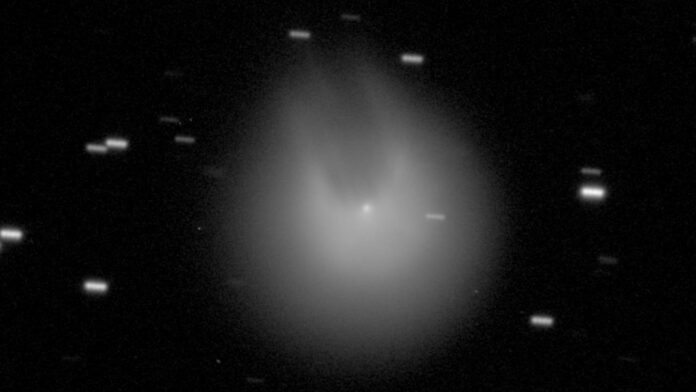An extraordinary volcanic comet heading toward the sun has displayed a remarkable phenomenon, appearing to have “grown horns” following its explosion. This resulted in the comet shining like a small star and releasing supercold “magma” into space. The eruption is a momentous event, as it marks the first time this comet has been observed erupting in nearly seven decades.
Known as 12P/Pons-Brooks (12P), the comet falls into the category of a cryovolcanic, or cold volcano, comet. Like other comets, it comprises a solid nucleus containing a mixture of ice, dust, and gas, enveloped by a hazy gas cloud called a coma that escapes from its interior.
However, what sets 12P apart is the substantial accumulation of gas and ice within its nucleus, leading to violent explosions that propel its frozen contents, referred to as cryomagma, through large fissures in the nucleus’s shell.
On July 20, multiple astronomers detected a significant outburst from the comet, causing it to brighten approximately 100 times more than its usual appearance.
This sudden surge in brightness occurred when the coma rapidly expanded due to the release of gas and ice crystals from the comet’s interior, enhancing its reflection of sunlight back to Earth.
By July 26, the comet’s coma had expanded to an impressive size of about 143,000 miles (230,000 kilometers) across, over 7,000 times wider than its estimated 18.6-mile (30 km) diameter nucleus. Richard Miles, an astronomer from the British Astronomical Association specializing in cryovolcanic comets, confirmed this information in an email to Live Science.
Interestingly, the expanded coma took on an irregular shape, giving the comet the appearance of having sprouted horns. Some experts have even likened the deformed comet to the iconic Millennium Falcon spaceship from Star Wars, as reported by Spaceweather.com.
The peculiar shape of the comet’s coma is likely due to an irregularity in the shape of 12P’s nucleus, as explained by Richard Miles. The outflowing gas was probably partially obstructed by an out-sticking lobe on the nucleus, creating a “notch” in the expanded coma.
As the gas continued to disperse and expand away from the comet, the notch, or “shadow,” became more noticeable. However, over time, the expanded coma will dissipate as the gas and ice disperse too widely to efficiently reflect sunlight.
This eruption marks the first major event detected from 12P in 69 years, primarily because its distant orbit places it too far away from Earth to easily observe such outbursts.
With one of the longest orbital periods among comets, 12P takes approximately 71 years to complete one full orbit around the sun. During this journey, it reaches the farthest regions of the solar system before approaching its closest point to the sun on April 21, 2024, and making its nearest approach to Earth on June 2, 2024. As a result, stargazers may have the opportunity to witness further eruptions from Earth’s vantage point in the night sky, as reported by Spaceweather.com.
In addition to 12P, scientists are also closely monitoring another volcanic comet, 29P/Schwassmann-Wachmann (29P), known as the most volatile volcanic comet in our solar system. In December 2022, astronomers witnessed the largest eruption from 29P in approximately 12 years, expelling around 1 million tons of cryomagma into space.
Moreover, in April of the same year, scientists accomplished a groundbreaking feat by accurately predicting one of 29P’s eruptions before it occurred. This achievement was possible due to a slight increase in brightness, indicating a higher gas leakage from the comet’s nucleus as it prepared to erupt.
